A History of Safety and Environmental Violations
Air Date: Week of April 9, 2010
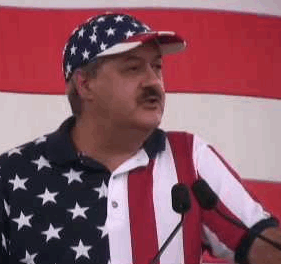
Massey Energy CEO Don Blankensip talking to the crowd at a Labor Day picnic he hosted.
The explosion at the Upper Big Branch coal mine in West Virginia may have been preventable. Massey Energy, the mine’s owner, has a long history of safety and environmental violations. Michael Shnayerson wrote a book “Coal River” about the powerful coal company. He tells host Jeff Young about Massey’s history and its CEO Don Blankenship.
Transcript
YOUNG: From the Jennifer and Ted Stanley Studios in Somerville, Massachusetts—this is Living on Earth. I’m Jeff Young. It’s the worst mining disaster in the U.S. in decades. As we record this program at least 25 miners are dead—killed in a massive explosion in the heart of West Virginia’s coal country. Officials and families are left with questions and grief.
MANCHIN: Rails, train rails that go back in? Look like they’ve been twisted like a pretzel. That’s horrific. That’s an explosion that—it’s just beyond proportion.
DAVIS: I kind of turned around and walked away from him, he’s like, ‘What, Dad?’ I said, ‘I love you, buddy’. He said, ‘I love you, too, Old Man. Now I’m gonna go cut me some coal.’ That’s my last words I heard from him.
YOUNG: We heard West Virginia Governor Joe Manchin and miner Tommy Davis, whose son, Cory was killed. Mr. Davis also lost his brother and nephew in the explosion. Mine safety investigators are still searching for an exact cause.
They’re also reviewing the safety record at the Upper Big Branch mine, which amassed more than 1,100 violations in the past three years, many of them serious. Federal regulators even ordered parts of the mine closed 60 times over the past year. The mine is just south of Charleston, the state capital, in the Coal River Valley. And all along the Valley are the scars coal mining has left on lives and the landscape.
[SOUNDS OF TRAINS AT CROSSING]
YOUNG: Follow Route 3 and the railroad tracks a few miles south from the disaster scene and you’ll find Marsh Fork Elementary. The school has been the staging center for media briefings since the explosion. Just uphill, another coal mine looms over the school. This one a massive mountaintop removal operation. Residents like Ed Wiley fear that mine and its lake of semi-liquid coal waste endangers school kids.
WILEY: And when you've got two point eight billion gallons of toxic sludge sitting over an elementary school, it's not good.
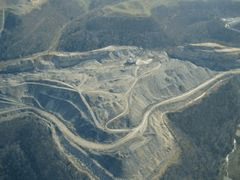
A mountain top removal mine in West Virginia (Photo: Jeff Young)
YOUNG: Just over the mountain to the west, Lora Webb watches the tiny community of Twilight disappear, as a coal company buys up houses and blasts away the mountains.
WEBB: I think if king coal has his way about it, I think that it'll be gone, it won't exist anymore. You know, what kind of treatment is that to the citizens of a community that's supplying the rest of America with power?
YOUNG: In neighboring Logan County, family members still grieve the deaths of two men lost in a mine fire in 2006. And just across the state line in eastern Kentucky, residents remember the massive spill of coal slurry ten years ago that destroyed streams nearly ten years ago.
All these incidents have one thing in common: Massey Energy. Massey is the country’s fourth largest coal producer, and has racked up record fines for safety and environmental violations. Writer and journalist Michael Shnayerson spent nearly three years reporting on Massey for his book, “Coal River”. Michael Shnayerson, welcome to Living on Earth.
SHNAYERSON: Hi, Jeff, nice to be here.
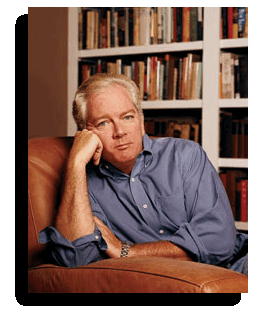
Michael Shnayerson is author of “Coal River” (Courtesy of Michael Shnayerson)
YOUNG: Now, part of your reporting for the book dealt with this very mine where the explosion took place—the Upper Big Branch mine, is that right?
SHNAYERSON: It did, yeah. The story of Upper Big Branch is in a sense a story of Massey in microcosm. It was a union operation, as really all the mines were in the coal fields at one time, but soon after Massey got a hold of it in the early ‘90s, Don Blankenship—the Chairman and CEO of Massey—made it his personal campaign to break the union at the mine. And so even though most of the miners were union miners, and you would think that in an election they would all vote for the union, Don began a personal campaign.
He would fly in on his helicopter to Upper Big Branch, he would take all the union miners to Dollywood, and those who seemed to be on the fence in their voting—new cars would mysteriously appear in their driveways. And, low and behold, he won the vote in 1997. And soon after that bonuses were cut, miners found themselves working longer hours, they had been working eight-hour shifts, now they work 12-hour shifts because that way the mine, which operated 24 hours a day only had two shifts—so only two shifts’ worth of health insurance, and fatalities occurred.
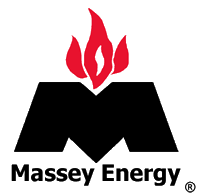
The Massey Energy Logo (Courtesy of the Library of Virginia)
YOUNG: In 2006 there was a fire at another Massey subsidiary mine called Aracoma nearby in Logan county. Two men were killed there and in the criminal investigation that followed we learned about a memo that Mr. Blankenship wrote, and it reads: “If any of you have been asked by your group president, supervisors, engineers, or anyone else to do anything other than run coal, you need to ignore them and run coal.”
SHNAYERSON: Well, in fairness, Don later disavowed that memo and said that safety was a top priority at Massey. But, you know, in the end the events and the facts speak for themselves. That particular disaster at Aracoma came after some 90 safety violations mostly for the problems that went on to cause the fire.
This tragedy that just occurred at Upper Big Branch seemed to have been the result of a methane explosion—well, all you can do to try to avoid the danger of a static explosion of methane is to ventilate the underground mine extremely well with huge fans and other things. It’s not hard to do, but the fact that this explosion appears to have come from it indicates, as do all the violations that Massey racked up in the last years, a real recklessness in regard to the measures that do need to be taken.
YOUNG: Let’s talk a bit about Mr. Blankenship, Massey’s CEO. Last year, he and his company sponsored a big Labor Day picnic where he had stars of country and rock music, and drew tens of thousands of people, and he gave a speech there railing against Washington regulation and climate change legislation.

Massey Energy CEO Don Blankensip talking to the crowd at a Labor Day picnic he hosted.
BLANKENSHIP CLIP: As someone who has overseen the mining of more coal than anyone else in the history of central Appalachia, I know that the safety and health of coal miners is my most important job. I don’t need Washington politicians to tell me that, and neither do you.
[CROWD CHEERING]
BLANKENSHIP CLIP: But, I also know—I also know that Washington and state politicians have no idea how to improve miner safety. The very idea that they care more about coal miner safety than we do is as silly as global warming.
SHNAYERSON: You know, for a storyteller, Don Blankenship is in a way a gift because he’s a storybook villain. And the thing is he doesn’t—one thing you have to say with sort of grudging respect is that Don doesn’t hide his true colors.
He is an avowed sort of Darwinian capitalist, and he feels that he needs to do as the head of Massey whatever is necessary to produce profits. And if safety measures get in the way, he’s going to tell his managers to, if not ignore them, to make them a second priority. And he’s taken a certain—I would say—glee in basking in his notoriety as the most aggressive coal baron and, in particular, the most aggressive mountaintop removal operator.
YOUNG: So, tell me what you learned about Massey’s record when it comes to environmental performance?
SHNAYERSON: To Massey the environment seems to be just an impediment to either be blasted away or, you know, ignored as it does its underground mining. Massey routinely racks up far, far more violations than any other coal companies in the region—and there are some large companies in the region, like Peabody or Consol. Massey just doesn’t seem to care about the environment, frankly.
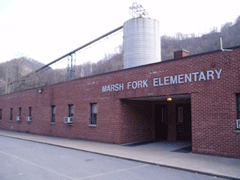
A Massey energy company coal silo looms over Marsh Fork Elementary. (Photo: Jeff Young)
YOUNG: And you reported on, as we have, this elementary school, Marsh Fork Elementary, which is literally in the shadow of a Massey coal operation.
SHNAYERSON: That’s right—one of Massey’s many subsidiaries, Goals Coal, actually operates right above a little public elementary school; it’s been there for decades. In recent years, what Massey has done is to drastically ramp up its mountaintop removal operations there, which necessitates creating an impoundment for all the liquid, sludgy waste, which creates this sort of ever-expanding mountain lake, if you will.
And if that lake happens to bust through its earthen barrier, it can just roll down a hillside and there’s a distinct danger—has been—that the 240 children of the Marsh Fork Elementary school could be drowned.
YOUNG: And we should mention that a failure of an impoundment like this one did occur at another Massey mine in eastern Kentucky and released something that was like 30 times what was released in the spill of the Exxon Valdez.
SHNAYERSON: Yes, indeed. In October of 2000 a Massey impoundment in Martin County, Kentucky did burst through its earthen barrier and a 300-million gallon spill of toxic sludge resulted. A little known fact is that the slurry spill in Martin County was actually the worst environmental disaster in the United States east of the Mississippi.
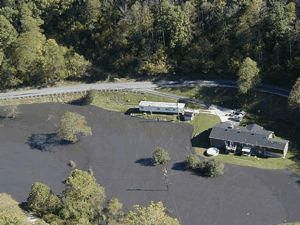
Coal Slurry escapes out of an earthen embankment near the Martin County Mine in Kentucky. (Courtesy of Archives Kentucky)
YOUNG: Do you think that Mr. Blankenship, and Massey Energy, has reached a turning point with the disaster at the Upper Big Branch Mine?
SHNAYERSON: Well, I think it’s unfortunately a little Polly-Annish to feel that a tragedy like this will change the way mining’s practiced. However, specific legislation always comes out of a truly large disaster like this. You know, one has to think that at least the tide of public opinion has turned against Massey long enough that they may be more careful for a while.
YOUNG: Michael Shnayerson, his book is “Coal River”. Thank you.
SHNAYERSON: Thank you, Jeff.
YOUNG: Massey Energy did not respond to our request for comment. We did reach the industry group that represents Massey and other coal companies, the National Mining Association. Carol Raulston is a spokesperson for the NMA.
RAULSTON: Massey has put a lot of effort and energy into improving its safety record over the last three to four years. In fact, last year they had three of the safest operations in all of American mining. So, they certainly have done an exemplary job in some operations. This operation may not meet those standards that they’d even set for themselves.
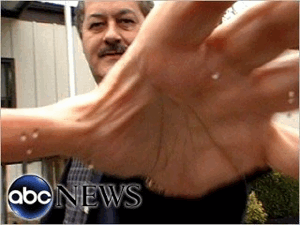
Massey Energy CEO Don Blakenship told an ABC News reporter “If you're going to start taking pictures of me, you're liable to get shot," just before grabbing the reporters camera.
YOUNG: Looking at the past record of this mine and of Massey’s mines, in general, it doesn’t look like a very good record and I’m wondering what responsibility your organization feels to make member companies like Massey improve their safety record.
RAULSTON: We have a constant safety awareness program that we’re involved in to continue to work with our members to improve their safety performance. It is our top priority at NMA.
YOUNG: Massey, of course, is also the company that in 2000 was responsible for a slurry spill. Massey’s a company that in 2007 the Environmental Protection Agency said it violated the Clean Water Act more than 4,000 times. At what point do you have to say to Massey Energy, ‘Clean up your act’?
RAULSTON: We believe it is the responsibility of every mining company to abide by the law and our members understand that. But I think right now—
YOUNG: But they’re clearly not!
RAULSTON: The focus right now is on supporting the family.
YOUNG: What are you doing to try to support the people in West Virginia?
RAULSTON: Obviously, we’ve been praying for them, we’re in contact with a number of them, and we’ve assisted with member companies who have sent more than 20 rescue teams there and a tremendous amount of equipment to assist in this second phase of the effort.
YOUNG: That’s Carol Raulston with the National Mining Association. There’s much more about Massey Energy and mine safety at our website, l-o-e dot org.
Links
Click here to hear a longer interview with Michael Shnayerson
Michael Shnayerson’s Home Page
LOE story on the Massey mine near Marsh Fork Elementary
LOE Story: EPA Eyes Mountaintop Removal Mining
LOE Story: Calculating Coal's Toll
LOE Story: Scientists Push Against EPA Decision
Mine Safety and Health Administion
LOE interviews mine inspector who tried to find the truth about Massey’s KY slurry spill
Living on Earth wants to hear from you!
Living on Earth
62 Calef Highway, Suite 212
Lee, NH 03861
Telephone: 617-287-4121
E-mail: comments@loe.org
Newsletter [Click here]
Donate to Living on Earth!
Living on Earth is an independent media program and relies entirely on contributions from listeners and institutions supporting public service. Please donate now to preserve an independent environmental voice.
Newsletter
Living on Earth offers a weekly delivery of the show's rundown to your mailbox. Sign up for our newsletter today!
 Sailors For The Sea: Be the change you want to sea.
Sailors For The Sea: Be the change you want to sea.
 The Grantham Foundation for the Protection of the Environment: Committed to protecting and improving the health of the global environment.
The Grantham Foundation for the Protection of the Environment: Committed to protecting and improving the health of the global environment.
 Contribute to Living on Earth and receive, as our gift to you, an archival print of one of Mark Seth Lender's extraordinary wildlife photographs. Follow the link to see Mark's current collection of photographs.
Contribute to Living on Earth and receive, as our gift to you, an archival print of one of Mark Seth Lender's extraordinary wildlife photographs. Follow the link to see Mark's current collection of photographs.
 Buy a signed copy of Mark Seth Lender's book Smeagull the Seagull & support Living on Earth
Buy a signed copy of Mark Seth Lender's book Smeagull the Seagull & support Living on Earth

